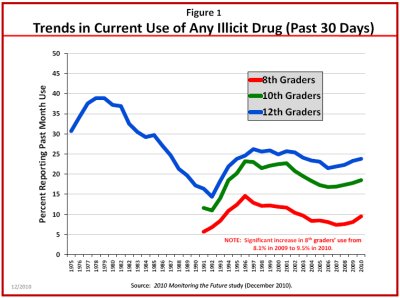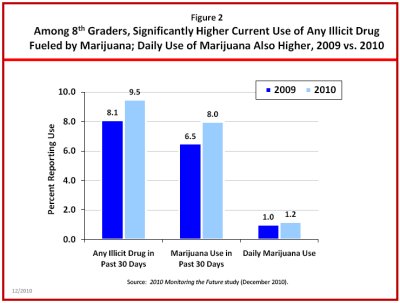2010 Monitoring the Future Study (MTF) HIGHLIGHTS.
2010 Monitoring the Future Study HIGHLIGHTS
 Monitoring the Future (MTF) is a nationally representative annual survey of 8th, 10th, and 12th graders conducted by the University of Michigan and funded by the National Institute on Drug Abuse (NIDA). This year’s survey results, released in December 2010, show increases in drug use and continued decreases in the perceived harm of using drugs – a worrisome combination. Of particular concern are increases in use occurring among 8th graders, the youngest of the three grades surveyed (see figure 1), suggesting the emergence of a new generation of potential users.
Monitoring the Future (MTF) is a nationally representative annual survey of 8th, 10th, and 12th graders conducted by the University of Michigan and funded by the National Institute on Drug Abuse (NIDA). This year’s survey results, released in December 2010, show increases in drug use and continued decreases in the perceived harm of using drugs – a worrisome combination. Of particular concern are increases in use occurring among 8th graders, the youngest of the three grades surveyed (see figure 1), suggesting the emergence of a new generation of potential users.
Continued erosions in young people’s perceptions of the harms associated with smoking marijuana, as well as with taking amphetamines and heroin, are very troubling. Last year’s MTF documented declines in the perceived risk of using marijuana occasionally or regularly among 8th graders; in 2010, use among 8th graders increased. This is a pattern, often seen in the MTF data, in which declines in perceived risk precede increases in use by one or two years. This year, measures of perceived risk of smoking marijuana decreased among 10th and 12th graders.
Increases in youth drug use, as reflected in the 2010 MTF results, are disappointing, and mixed messages about drug legalization – particularly of marijuana – may be contributing to the trend. Such messages only hinder the efforts of parents who are trying to prevent their kids from using drugs. The Obama Administration is addressing the threat of drug use and its consequences through a balanced and comprehensive drug control strategy. Even so, parents and other adults who influence children must take a primary role in teaching young people about the serious risks associated with drug use.
Warning Signs
Monitoring the Future collects data for lifetime use, past 12-month use, past 30-day use, and, for some specific substances, daily use. Data on past 30-day use are often most significant because they provide estimates of current use. The Study also collects information on attitudes about the dangers associated with drug use and perceptions about drug availability.
 The latest MTF results found increases over 2009 in past-month and past-year use of marijuana among 8th graders – increases that, in turn, drove rising rates of past-month and past-year use of any illicit drug (see figure 2).
The latest MTF results found increases over 2009 in past-month and past-year use of marijuana among 8th graders – increases that, in turn, drove rising rates of past-month and past-year use of any illicit drug (see figure 2).
Additionally, daily use of marijuana among all three grades increased between 2009 and 2010. The 2010 data also indicate increases in past-month and past-year use of LSD among 12th graders, past-month and past-year use of ecstasy among 8th and 10th graders, and past-month and past-year use of injected heroin among 12th graders.
For some drugs, however, the 2010 MTF documented declines in the prevalence of use, including past-year use of GHB among 10th graders, past-year use of Vicodin among 12th graders, past-year steroid use among 10th graders, and past-month and binge drinking of alcohol (five or more drinks in a row) within the past two weeks among 12th graders.
Decreases in the perceived availability of cocaine are heartening, and correlate to other data indicating a softening of the cocaine market.
A Closer Look
Past-month and past-year use of marijuana increased from 2009 to 2010 among 8th graders only (from 6.5% to 8.0% and 11.8% to 13.7%, respectively). These increases drove similar increases in the past-month and past-year use of any illicit drug among 8th graders (from 8.1% to 9.5% and 14.5% to 16%, respectively).
In 2010, significant increases in daily marijuana use were found among 8th, 10th, and 12th graders (1.0% to 1.2%, 2.8% to 3.3%, and 5.2% to 6.1%, respectively).
Past 30-day, past-year, and lifetime use of ecstasy increased among 8th graders (0.6% to 1.1%; 1.3% to 2.4%; and 2.2% to 3.3%, respectively), and past 30-day and past-year use increased among 10th graders (1.3% to 1.9% and 3.7% to 4.7%).
In 2010, increases in past 30-day (0.5% to 0.8%) and past year (1.9% to 2.6%) use of LSD were found among 12th graders.
Among high school seniors, lifetime, past-year, and past-month use of heroin with a needle increased (0.6% to 1.1%; 0.3% to 0.7%; and 0.1% to 0.4%, respectively).
Drug use, especially the use of alcohol, marijuana, and the non-medical use of prescription drugs, remain unacceptably high:
- After alcohol, marijuana is far and away the most commonly used drug, with past-year use reported by 34.8% of 12th graders, 27.5% of 10th graders, and 13.7% of 8th graders.
- About one in twelve (8.0%) 12th graders reported using Vicodin in the past year, closely followed by non-medical use of seven other legitimate drugs: amphetamines (7.4%), tranquilizers (5.6%), over-the-counter cough or cold medicines (6.6%), Adderall (6.5%), sedatives (4.8%), OxyContin (5.1%), and Ritalin (2.7%).
- Among 8th graders, use of inhalants ranks second (after marijuana), with 8.1% reporting past-year use, followed by non-medical use of seven legitimate drugs: amphetamines (3.9%), cough medicine (3.2%), tranquilizers (2.8%), Vicodin (2.7%), Adderall (2.3%), OxyContin (2.1%), and Ritalin (1.5%).
Additionally, changes were found in attitudes and perceptions:
- Among 8th graders, three indicators of disapproval of others who try or smoke marijuana worsened:
 Trying once or twice (-1.8 points),
Trying once or twice (-1.8 points),
 Smoking occasionally (-2.0 points), and
Smoking occasionally (-2.0 points), and
 Smoking regularly (-1.5 points).
Smoking regularly (-1.5 points). - Among 10th graders, those who perceived “great risk” of harm associated with smoking marijuana occasionally or regularly declined 2.0 and 2.3 percentage points, respectively.
- Among 12th graders, those who perceived “great risk” of harm associated with smoking marijuana regularly declined 5.6 percentage points. Also disturbing is that among 12th graders, those who perceived risk of using heroin occasionally or regularly declined 4.8 and 4.3 percentage points, respectively. Perception of risk in using amphetamines regularly declined 5.4 percentage points.
- Among 12th graders, disapproval of others who try or smoke marijuana occasionally worsened (-3.6 percentage points).
- Among 12th graders, the perceived risk of using cocaine occasionally or regularly declined (3.6 and 2.7 points, respectively).
Good News
Decreases in the use of various substances between 2009 and 2010 include the following:
- Vicodin: Among 12th graders, past-year use decreased from 9.7% to 8.0%.
- Alcohol: Past 30-day use among high school seniors dropped from 43.5% to 41.2%, and the prevalence of five or more drinks in a row within the past two weeks declined from 25.2% to 23.2%.
- GHB: Past-year use among 10th graders went down 0.4 percentage points (from 1.0% to 0.6%).
- Steroids: Past-year use among 8th graders dropped from 0.8% to 0.5%.
- Flavored alcoholic beverages: Among 12th graders, lifetime, past-year, and past-month use declined 4.8, 5.5, and 3.3 percentage points, respectively.
Perceived Harm 2009-2010
- Among 10th graders, the perceived harm of trying powder cocaine once or twice increased 2.1 percentage points to 52.9%.
- Among 8th graders, two measures of the perceived harm of trying or using various substances improved (increased) in 2010: trying crack once or twice (+3.0 points); or trying powder cocaine once or twice (+3.3 points), respectively.
Perceived Availability 2009-2010
- Several measures of the perceived availability of various substances improved (declined) among high school seniors in 2010: crack (-5.9 points to 26.1%), cocaine powder (-3.9 points to 35.5%), meth ice (-4.9 points to 29.0%), and heroin (-3.3 points to 24.1%).
- Among 10th graders, the perceived availability of cocaine powder dropped 2.1 percentage points to 22.6%.



















